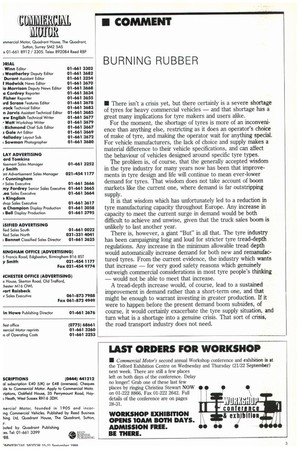BURNING RUBBER
Page 3

If you've noticed an error in this article please click here to report it so we can fix it.
• There isn't a crisis yet, but there certainly is a severe shortage of tyres for heavy commercial vehicles — and that shortage has a great many implications for tyre makers and users alike.
For the moment, the shortage of tyres is more of an inconvenience than anything else, restricting as it does an operator's choice of make of tyre, and making the operator wait for anything special. For vehicle manufacturers, the lack of choice and supply makes a material difference to their vehicle specifications, and can affect the behaviour of vehicles designed around specific tyre types.
The problem is, of course, that the generally accepted wisdom in the tyre industry for many years now has been that improvements in tyre design and life will continue to mean ever-lower demand for tyres. That wisdom does not take account of boom markets like the current one, where demand is far outstripping supply.
It is that wisdom which has unfortunately led to a reduction in tyre manufacturing capacity throughout Europe. Any increase in capacity to meet the current surge in demand would be both difficult to achieve and unwise, given that the truck sales boom is unlikely to last another year.
There is, however, a giant "But" in all that. The tyre industry has been campaigning long and loud for stricter tyre tread-depth regulations. Any increase in the minimum allowable tread depth would automatically increase demand for both new and remanufactured tyres. From the current evidence, the industry which wants that increase — for very good safety reasons which genuinely outweigh commercial considerations in most tyre people's thinking — would not be able to meet that increase.
A tread-depth increase would, of course, lead to a sustained improvement in demand rather than a short-term one, and that might be enough to warrant investing in greater production. If it were to happen before the present demand boom subsides, of course, it would certainly exacerbate the tyre supply situation, and turn what is a shortage into a genuine crisis. That sort of crisis, the road transport industry does not need.






























































